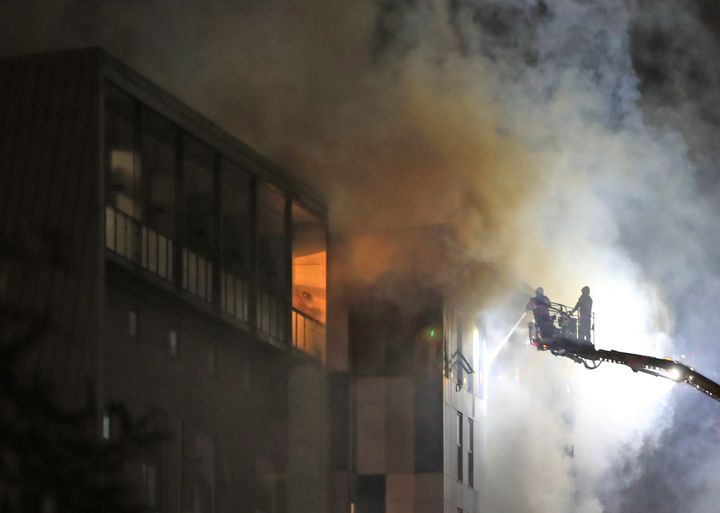A fire safety regulation that exempts buildings under 18m tall from restrictions on certain types of controversial cladding has been described as “wholly insufficient” after it emerged the student block that burned down last week in Bolton was just 14cm short of qualifying.
FIrefighters have confirmed that The Cube building, destroyed on Friday, did not have the same type of cladding (ACM) that combusted in the fatal Grenfell Tower fire of 2017, but was instead fitted with high-pressure laminate (HPL) coloured panels.
The government has deemed HPL less risky than ACM, but still in need of removal from high-rise buildings if it isn’t paired with fire-resistant insulation. If, however, a building is under 18m, this isn’t a requirement.
HuffPost UK contacted the designers of The Cube, RADM Architects, but they refused to answer questions about the building. Their website has also been taken down but an archived version shows it previously led with an image of the student block.

Both types of combustible material were banned on new buildings in December last year but have only been marked for removal on buildings classed as high-rise residential buildings (HRRBs) – those 18m and taller.
In a statement to HuffPost UK, the Fire Brigades Union (FBU) general secretary Matt Wrack said this height was based on the use of wheeled escape ladders that “have not been in widespread use since the late 1980s”.
Instead the FBU argues the restrictions for cladding such as HPL should be extended to buildings of 11m – the height modern-day fire brigade cherry-pickers can reach.
Wrack added: “There is no sensible reason why we should only care about the safety of those in buildings over 18m, nor why we should only try to remove one particular kind of flammable cladding.
“This Tory government have sat on their hands on fire safety for too long. They’ve done the bare minimum. This government has not grasped and does not want to grasp the scale of the fire safety crisis in the UK. It’s sickening.”
The Cube housed more than 200 students at the University of Bolton. Valeo Urban Student Life (USL), which manages the building for the private owners, said that Friday night’s fire started on the fourth floor and spread to the sixth floor.

The town centre complex in Bradshawgate, described as “luxury student accommodation”, consists of two blocks and only the rear block was damaged, said USL.
On Sunday, Greater Manchester Fire and Rescue Service confirmed the rear block was just under 18 metres and therefore not classed as a high-rise.
Planning documents from 2013 suggest the building was originally considered for cladding in ACM. It is not known when the plans were changed.
Eva Crossan Jory, vice president of Bolton University’s Student Union, told HuffPost UK they have been “consistently calling for the government to take more urgent action” over the cladding on student housing.
She added: “Student accommodation providers make enormous profits, and we are concerned that in the rush to expand some may have cut corners.
“We want to see immediate action from government to audit all cladding that could be causing fire-safety issues and have it removed it immediately if it is likely to exacerbate a fire. This should also take into account buildings that fall below the 18m ‘high-rise’ definition.”
Labour this week pledged to name and shame owners of blocks still fitted with dangerous cladding, and give councils more power to fine owners without a plan to pull it off their blocks.
Shadow housing secretary John Healey said it was “shameful” that blocks still existed with flammable cladding more than two years on from the Grenfell fire. The tower block in Kensington burnt down in June 2017, killing 72 people.
The government is on course to miss its 2020 target for all high-rise blocks having ACM removed by more than a decade at the current rate: 318 private and public buildings remain at risk, 18 of which are student high-rises.
A majority of the social housing clad in ACM has at least begun having it removed, but the picture is different for private homes, where 144 out of 184 at risk haven’t even seen work start.
A Ministry of Housing, Communities and Local Government (MHCLG) spokesperson told HuffPost UK in a statement: “We have repeatedly made clear that building owners must ensure their residents are safe in their homes.
“We have told building owners how to check the type of cladding on their building and that if it is not safe it must be removed.
“We have also provided councils with funding so they can find out the type of cladding on all high-rise buildings in the country and have tested a number of non-ACM materials, including high pressure laminates, to assess whether any further action is necessary.”
